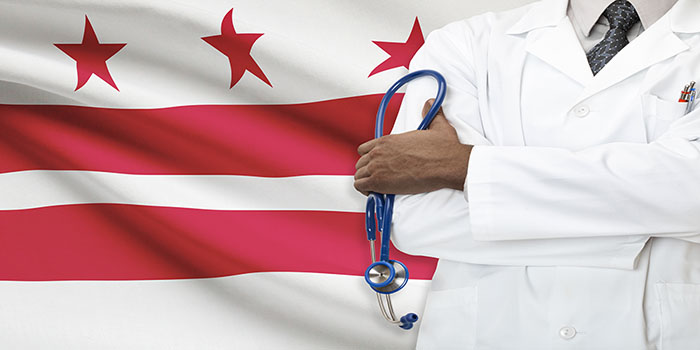In late December 2019, officials from the central Chinese city of Wuhan reported an outbreak of a mysterious respiratory illness. This illness, later named COVID-19, is caused by a new strain of coronavirus called SARS-CoV-2. The virus is thought to have evolved in bats or pangolins before jumping to humans, in what is called a zoonotic transmission.
Within a matter of months, COVID-19 had progressed to a global pandemic. As of April 29 2020, there were more than 3.1 million laboratory-confirmed cases of COVID-19 and more than 219,000 COVID-19 related deaths worldwide.
Countries have had varying response to this pandemic. Here in America, states and territories have also launched their own measures to “flatten the curve” and slow the spread of COVID-19. Local and federal officials are working hard to strike a balance between protecting public health, honoring individual freedoms, and preserving the economy.
In the fight against COVID-19, how has Washington DC fared?
COVID-19 in the DC Community: Latest Updates by the Numbers
According to the latest official data, there are 4,106 total confirmed cases of COVID-19 in DC, along with 205 COVID-19 related deaths. 660 people have recovered, and overall 19,229 people have been tested. All eight wards in the DC district have been affected by the coronavirus pandemic, with the greatest number of confirmed cases coming out of Ward 4.
Washington DC is the 34th state in the nation in number of cases. Recent antibody testing results also suggest that COVID-19 may have been present in the district much earlier than initially thought—perhaps as far back as mid-February.
Mayor Muriel Bowser’s office also regularly shares updates regarding the district’s hospital status. The following information is current as of April 28, 2020:
- Total ICU Beds in Hospitals: 345
- ICU Beds Available: 136
- Total Reported Ventilators in Hospitals: 440
- In-Use Ventilators in Hospitals: 206
- Available Ventilators in Hospitals: 234
In other word, there are more ICU beds and ventilators available than are currently being used. Indeed, there are nearly two dozen more ICU beds available compared to April 26 (understanding, of course, that these figures can and do change daily). The indication is that DC-area hospitals are able to meet the demands of the pandemic, at least for now. However, officials warn of a possible surge in cases and deaths in June.
Assessing DC Officials’ Response to COVID-19 and Its Impact on the Local Healthcare System
The following efforts are being made in response to the unique challenges that the COVID-19 pandemic has imposed on the DC healthcare system:
- Social distancing: Mayor Bowser recently extended the district’s state of emergency and public health emergency through May 15, 2020. This is intended to slow the spread of infection and prevent a surge in COVID-19 cases, which could otherwise overwhelm the healthcare system’s capacity. Social distancing guidelines include closing all schools and non-essential businesses, only leaving the home for essential business, and wearing a mask when leaving the home.
- Funding: according to DC officials, 10 local hospitals have been awarded a total of $25 million in grants to prepare for the potential COVID-19 surge, as part of the COVID-19 Response Supplemental Emergency Amendment Act of 2020. Funds are intended to go toward much-needed personal protective equipment (PPE) and other supplies, personnel, and “construction and operation of temporary structures for testing and treatment.”
- PPE shortage: despite the recent funding announcements, medical facilities in the DC area are still rationing PPE such as gowns, gloves, surgical masks, and N95 respirators. Local officials are also asking for donations so that healthcare workers get the essential PPE they need.
- Testing: experts say widespread testing helps slow the spread of COVID-19. For this reason, DC officials are reportedly now testing essential workers, including grocery store employees, for free if workers believe they have been exposed to the SARS-CoV-2 virus.
- Accommodating healthcare workers: George Washinton University recently converted empty dormitory buildings into temporary housing for frontline medical workers, according to the Washington Post. This offers respite to healthcare personnel who may be fearful of exposing their loved ones and other household members to the virus.
Conclusion
Washington DC is still considered a “hotspot” for COVID-19 cases according to some news reports. It’s yet to be seen whether a surge in cases and deaths will hit, and to what extent DC hospitals and frontline medical workers will be prepared to handle the potential crisis.
It does seem that the DC healthcare system is taking precautionary steps and making resources available to support the community.
***
coronavirus.dc.gov/page/coronavirus-data
https://www.statista.com/statistics/1102807/coronavirus-covid19-cases-number-us-americans-by-state/
Reports of PPE shortage at VA facilities raise questions from lawmakers
https://www.npr.org/local/305/2020/04/07/828820329/d-c-area-c-o-v-i-d-19-equipment-shortage-sparks-creative-solutions-pleas-for-donations
https://dcra.dc.gov/release/dcra-service-updates-around-covid-19#:~:text=Construction%20continues%20to%20be%20allowed,construction%20throughout%20the%20District.


















Add comment